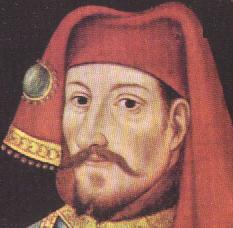Henry IV of England
|
|
| Missing image Henry_IV_of_England_-_Illustration_from_Cassell's_History_of_England_-_Century_Edition_-_published_circa_1902.jpg Henry IV of England, depicted in Cassell's History of England, Century Edition, published circa 1902 |
Henry IV (April 3, 1367 – March 20, 1413) was born at Bolingbroke Castle in Lincolnshire, hence the other name by which he was known, "Henry of Bolingbroke". His father, John of Gaunt was the third and oldest surviving son of King Edward III of England, and enjoyed a position of considerable influence during much of the reign of Richard II. Henry, however, had a rather more equivocal relationship with Richard: they were first cousins and childhood playmates, and were admitted together to the Order of the Garter in 1377, but Henry participated in the Lords Appellants rebellion against the King in 1387. After regaining power, Richard did not punish Henry (many of the other rebellious barons were executed or exiled), and in fact elevated him to Duke of Derby. The relationship between Henry and the King reached a second crisis in 1398, when Richard banished Henry from the kingdom for ten years -- with John of Gaunt's approval -- to avoid a blood feud between Henry of Bolingbroke and Henry of Derby (who was exiled for life).
The following year, however, John of Gaunt died, and without explanation, Richard cancelled the legal documents that would have allowed Henry to inherit Gaunt's land automatically -- instead, Henry would be required to ask for the lands from Richard. After some hesitation, Henry met with the exiled Thomas Arundel, former (and future) Archbishop of Canterbury, who had lost his position because of his involvement with the Lords Appellant, and Henry and Arundel returned to England while Richard was on a military campaign in Ireland. With Arundel as his advisor, Henry Bolingbroke began a military campaign, confiscating land from those who opposed him and ordering his soldiers to destroy much of Cheshire. Quickly, Henry gained enough power and support to have himself declared King Henry IV, imprisoning King Richard (who died in prison under mysterious circumstances) and by-passing Richards heir-apparent Edmund Mortimer. Henry's coronation, on October 13, 1399, is notable as the first time following the Norman Conquest that the monarch made an address in English. Henry consulted with parliament frequently, but was sometimes at odds with them, especially over ecclesiastical matters. On Arundel's advice, Henry was the first English king to allow the burning of heretics, mainly to suppress the Lollard movement.
In 1380 Henry had married Mary de Bohun; they had two daughters and four sons, one of which was the future Henry V of England. In 1406, one of their daughters, Philippa, married Eric of Pomerania, king of Denmark, Norway and Sweden. Mary died in 1394, and in 1403 Henry married Joanna of Navarre, the daughter of Charles d'Evreux, King of Navarre. She was the widow of John IV of Brittany, with whom she had four daughters and four sons, but she and Henry had no children. The fact that in 1399 Henry had four sons from his first marriage was undoubtedly a clinching factor in his acceptance onto the throne. By contrast, Richard II had no children, and Richard's heir-apparent Mortimer was only seven years old.
Henry spent much of his reign defending himself against plots, rebellions and assassination attempts. His first problem was what to do with the deposed Richard, and after an early assassination plot was foiled, he probably ordered his death by starvation in early 1400, although there is no evidence for this. Richard's body was put on public display in the old St Paul's Cathedral to show his supporters that he was dead.
Rebellions continued throughout the first ten years of Henrys reign, including the revolt of Owen Glendower who declared himself Prince of Wales in 1400, and the rebellion of Henry Percy, 1st Earl of Northumberland. The king's success in putting down these rebellions was due partly to the military ability of his eldest son, Henry, who would later become King Henry V of England, though the younger Henry himself (who had maintained a close relationship with Richard II) managed to seize much effective power from his father in 1410.
In 1406, English soldiers captured the future James I of Scotland as he was going to France. James remained a prisoner of Henry for the rest of Henry's reign.
The later years of Henry's reign were marked by serious health problems. He had some sort of disfiguring skin disease, and more seriously suffered acute attacks of some grave illness in June 1405, April 1406, June 1408, during the winter of 1408–9, December 1412, and then finally a fatal bout in March 1413. Medical historians have long debated the nature of this affliction or afflictions. The skin disease might have been leprosy (which in any case didn't mean precisely the same thing as it does to modern medicine), perhaps psoriasis, a symptom of syphilis, or something else. The acute attacks have been given a wide range of explanations, from epilepsy to some from of cardiovascular disease.
In 1413, he died in the Jerusalem Chamber in the house of the Abbot of Westminster. He was buried in Canterbury Cathedral. His body was well embalmed, as an exhumation some centuries later established.
| Preceded by: Humphrey de Bohun abeyant | Earl of Northampton | Succeeded by: Anne Plantaganet
|

